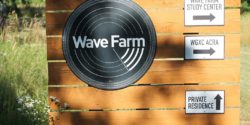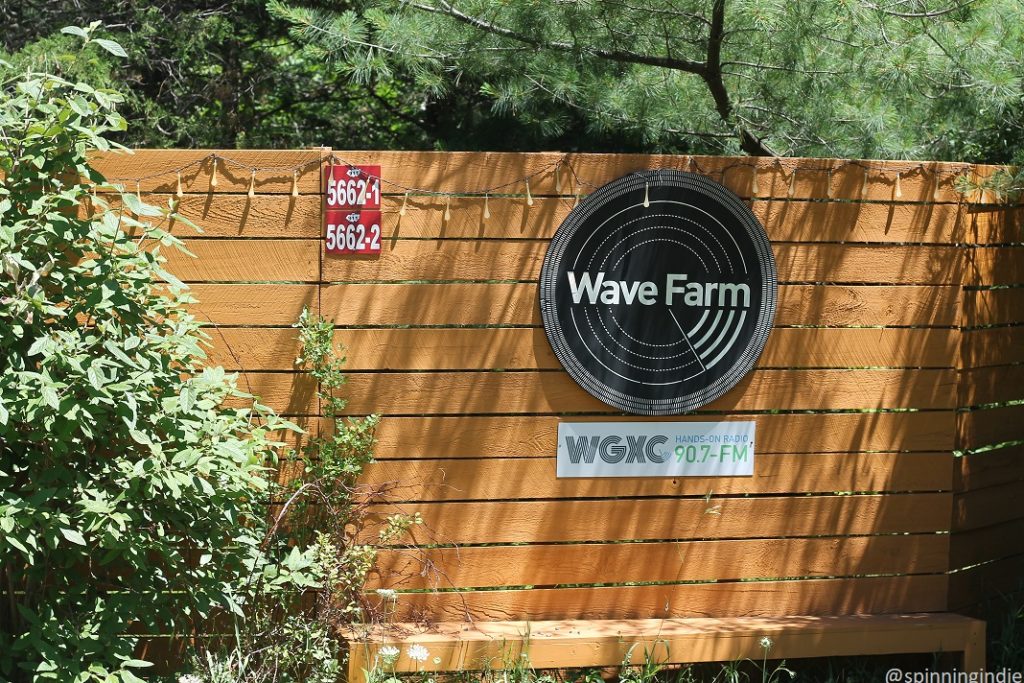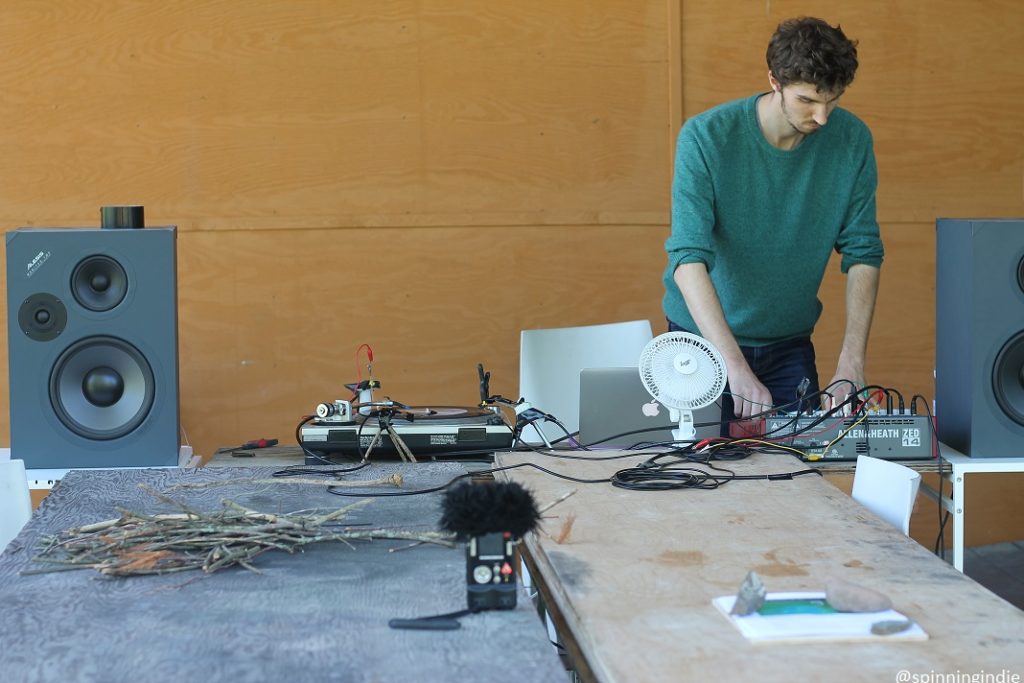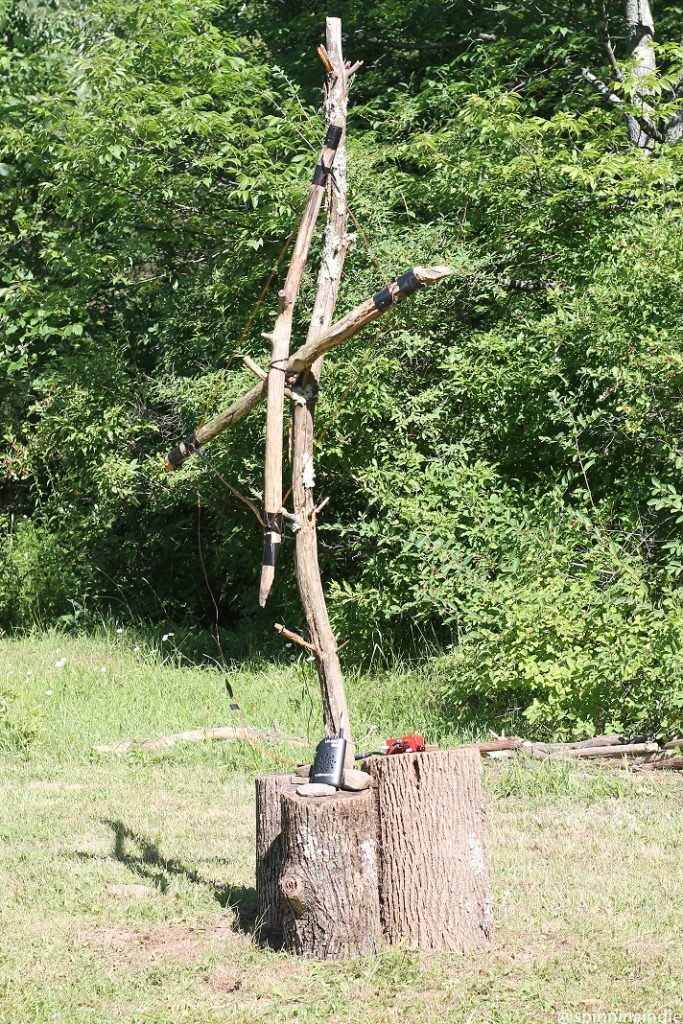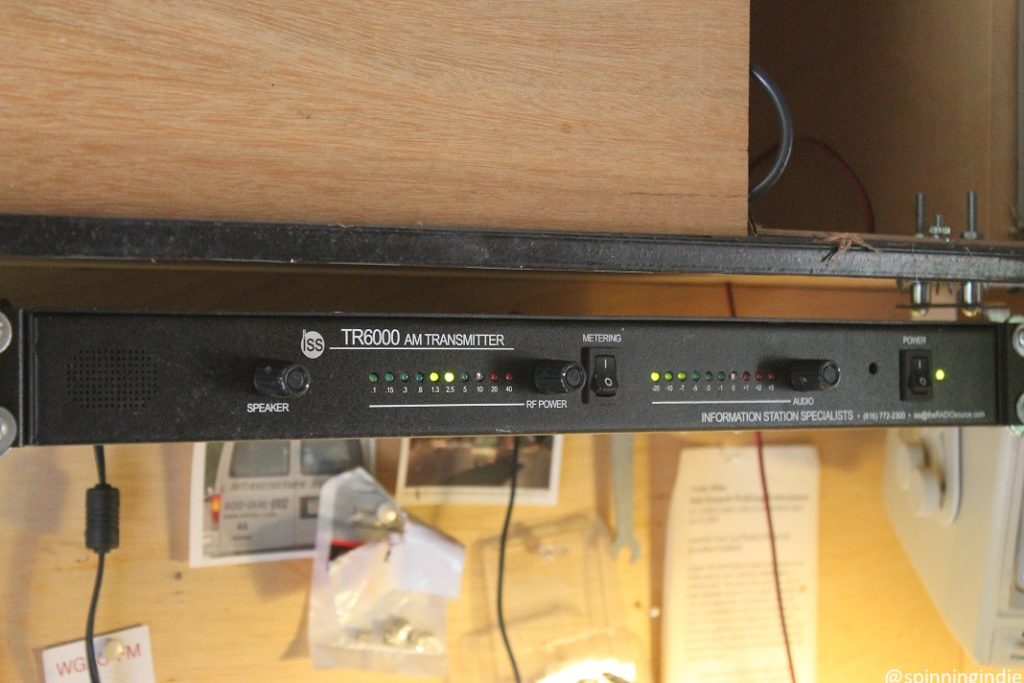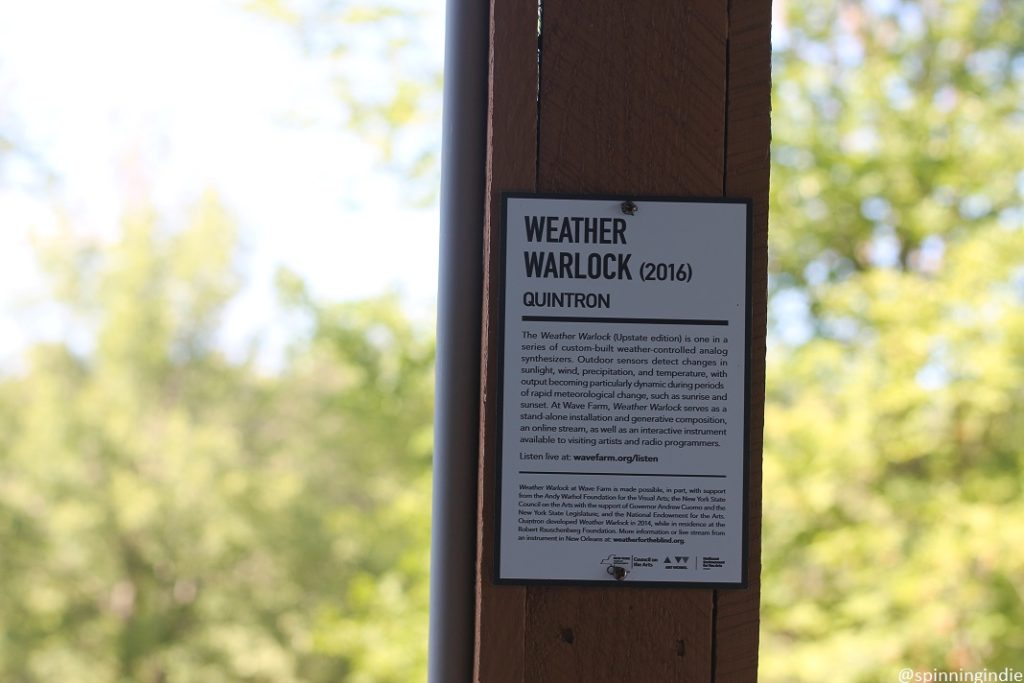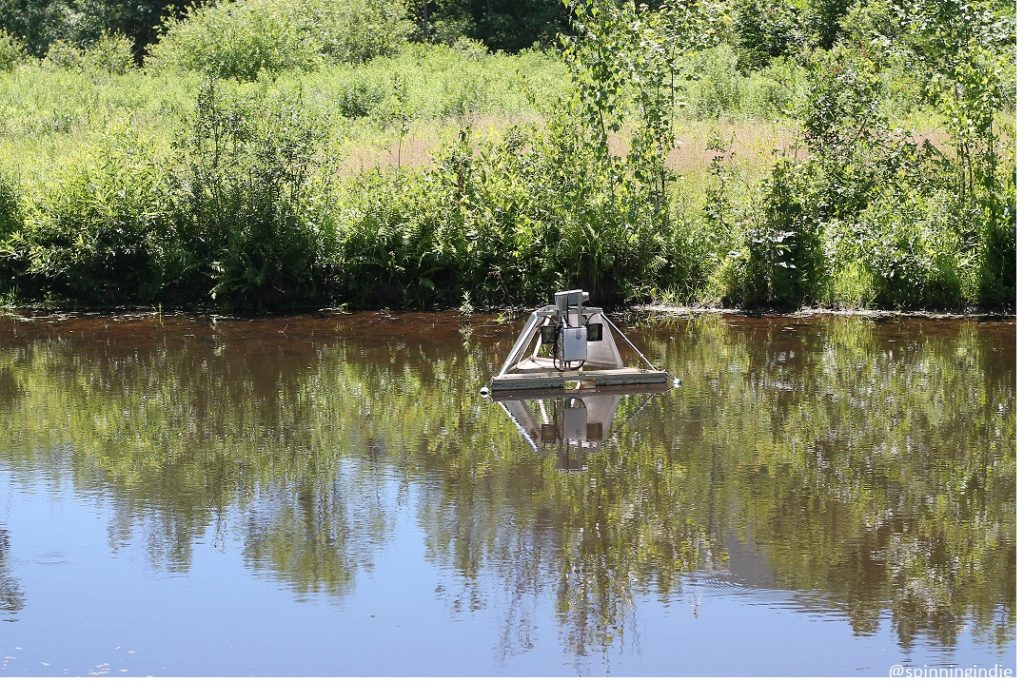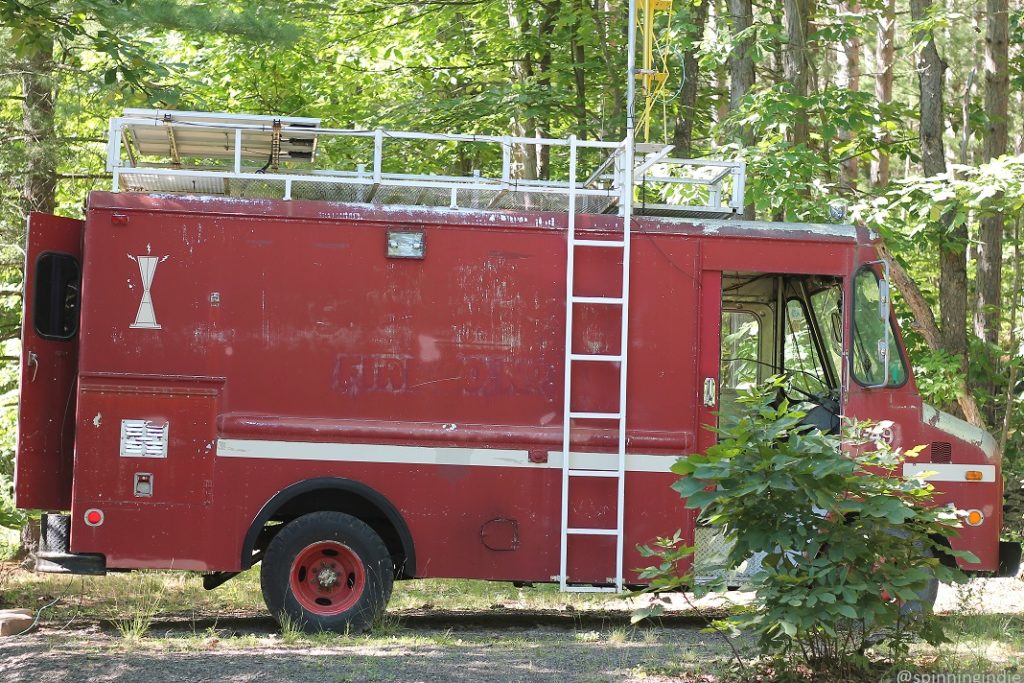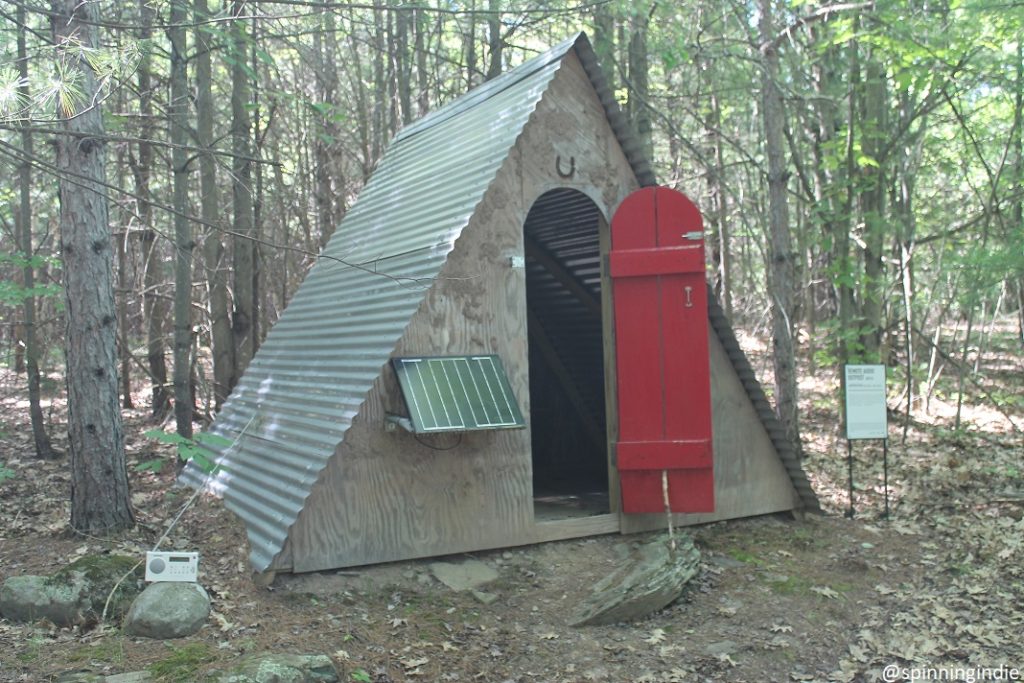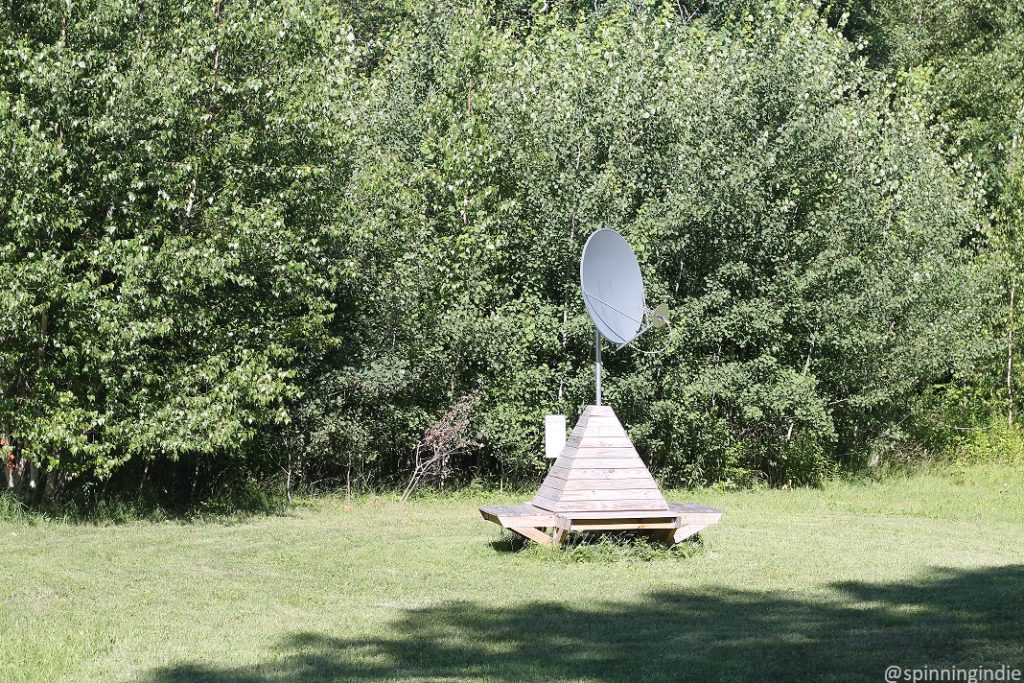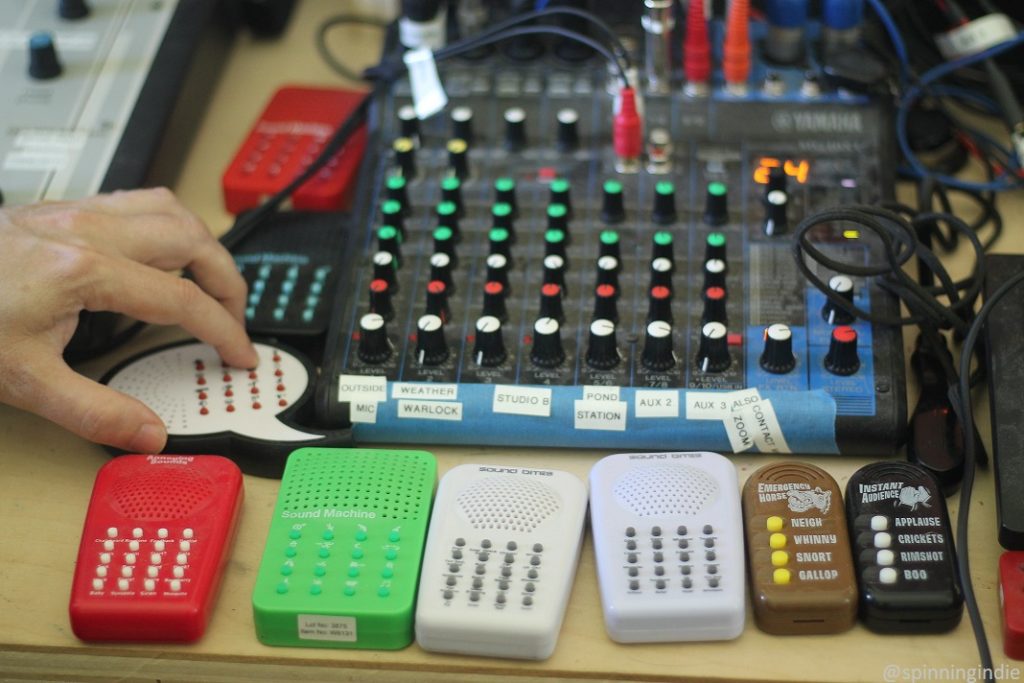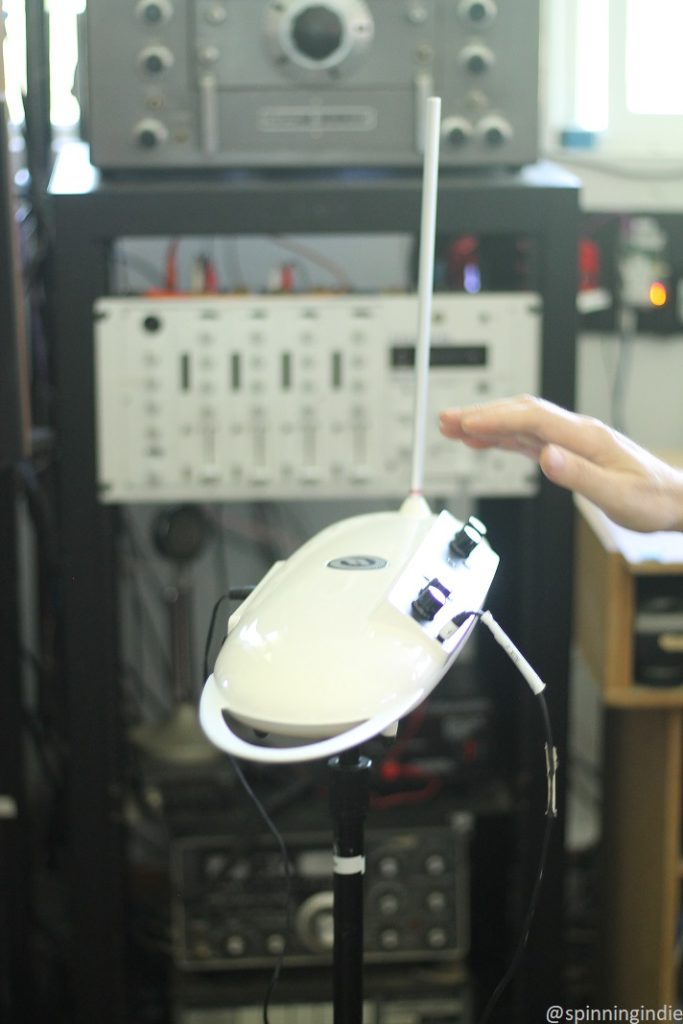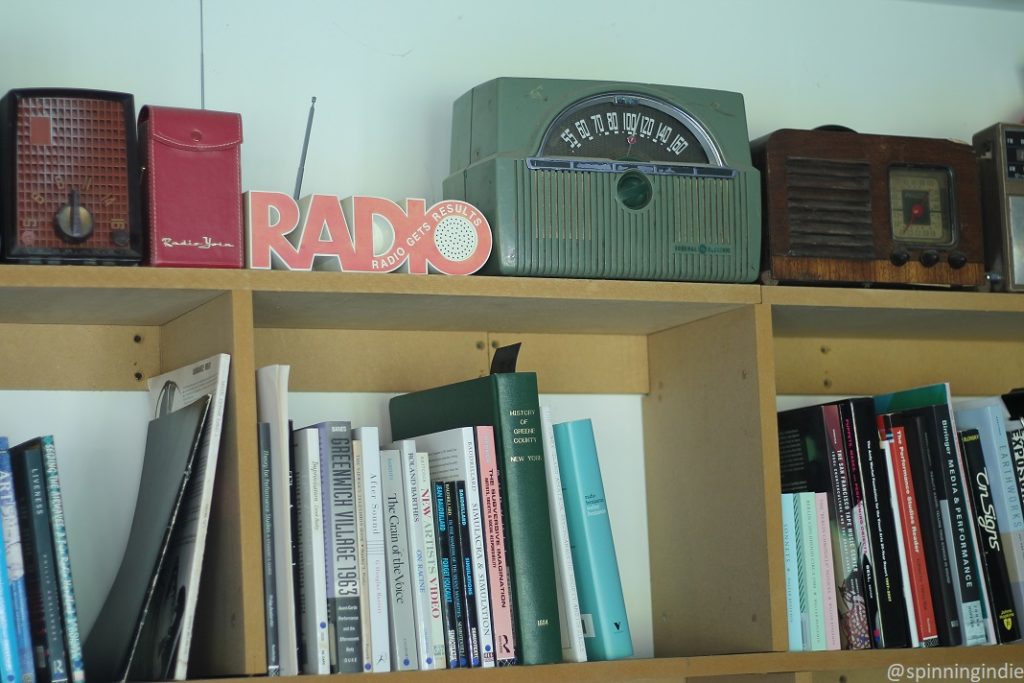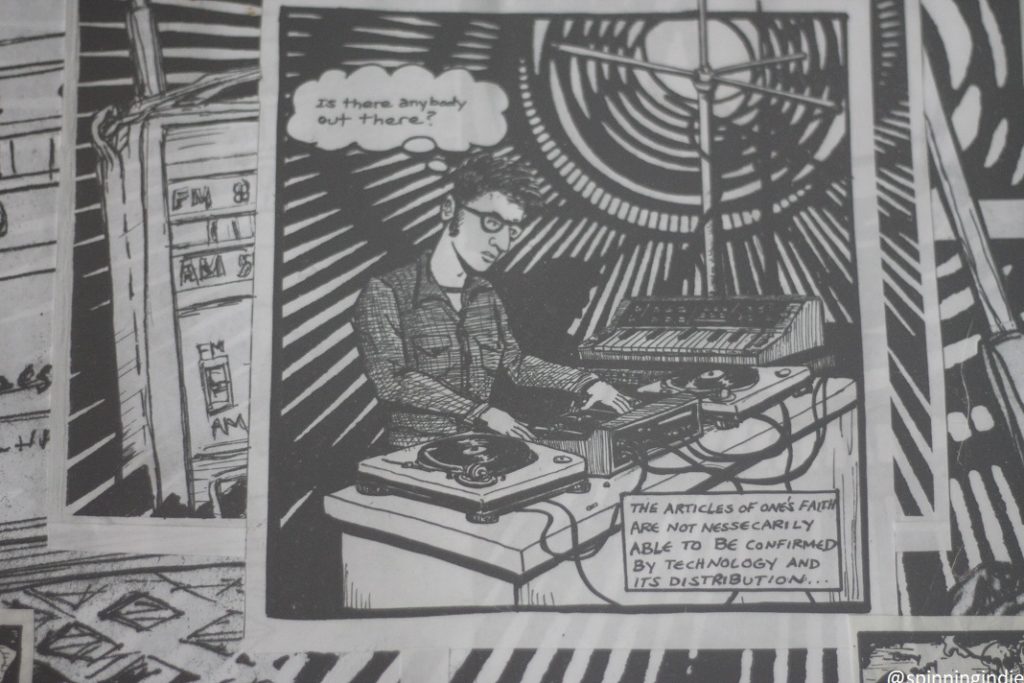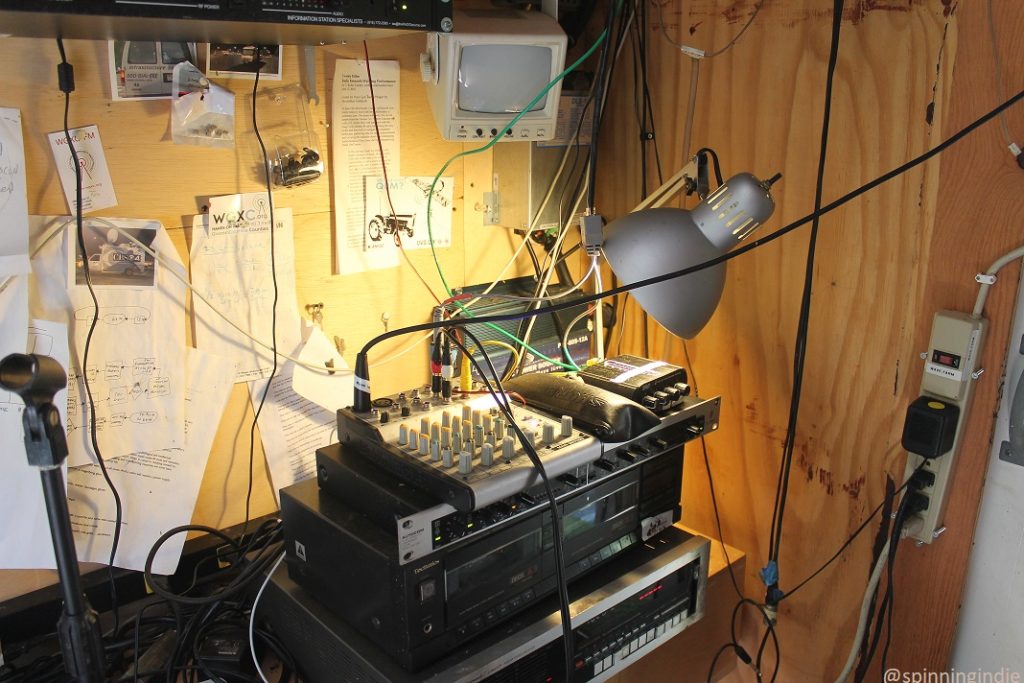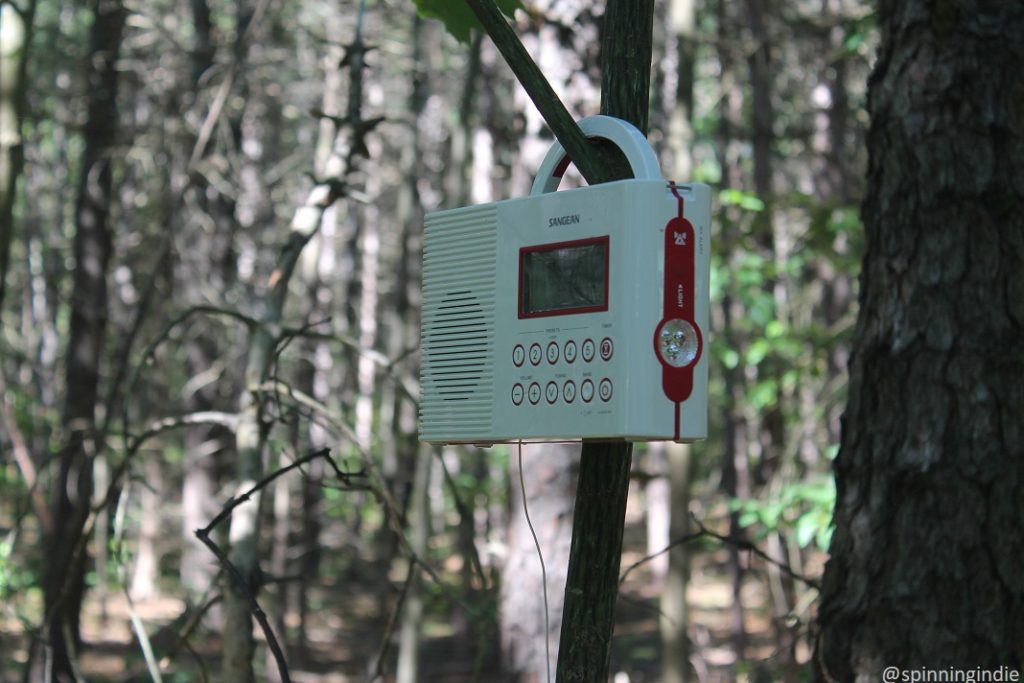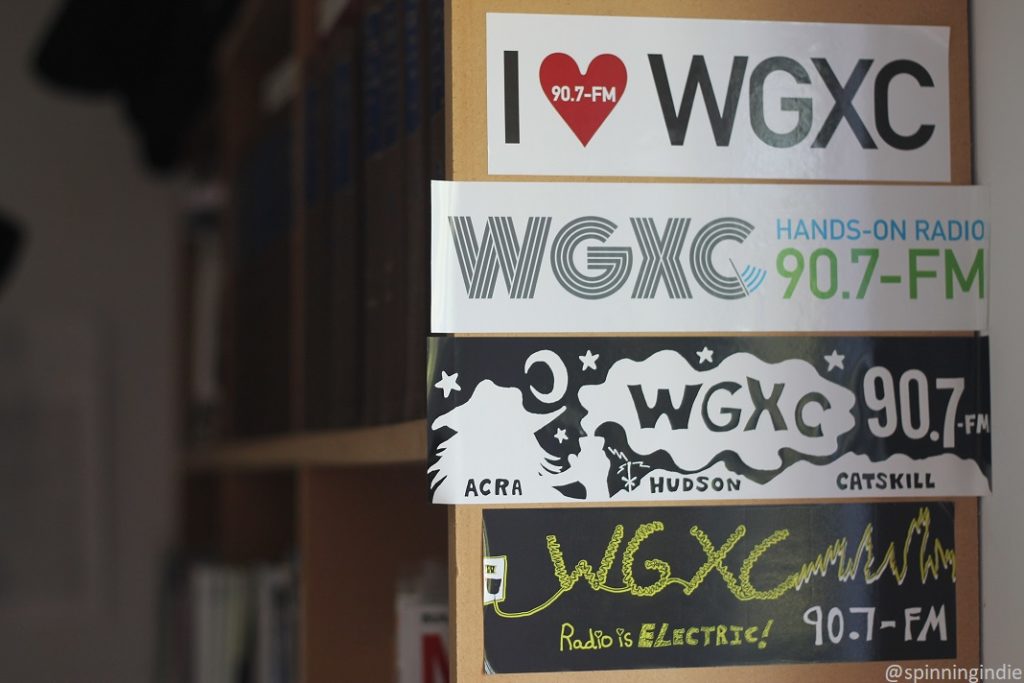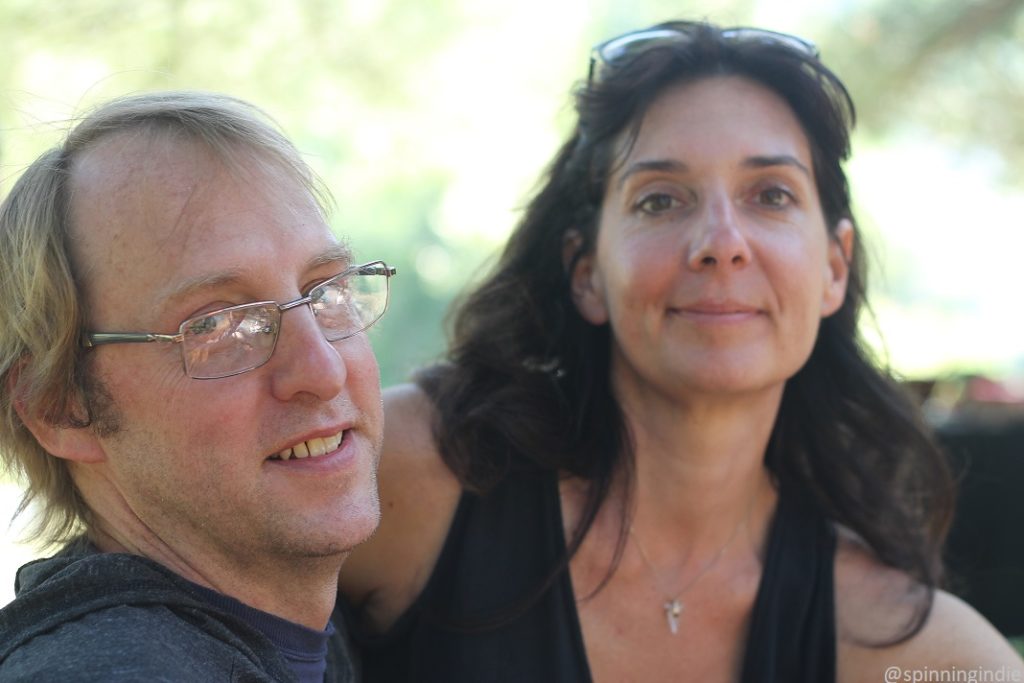Radios in the woods, a pond station, and a Theremin are just a few of the goodies to be seen and heard at Wave Farm in Acra, New York. A non-profit arts organization, Wave Farm runs community radio station WGXC-FM and offers grants and residencies in transmission arts. For a radio nerd like me, a summer afternoon spent at Wave Farm was a dream come true. The day prior, I got a preview, as I toured WGXC’s studio in Hudson, New York (the subject of my next station visit post) – one of two full-time studios for the station.
When I arrived at Wave Farm, artist-in-residence Dan Tapper was outside of Wave Farm’s Study Center setting up for a live performance, the culmination of his week-long stay in Acra. His project, Seven Songs for Seven Planets and a Black Hole at the Heart of the Universe, was comprised of a series of “interdisciplinary works,” including installations, broadcasts, and performance. An accompanying flyer explains that, “The material for the works has been developed by Dan during the residency period and focuses on using data from space and physics – specifically our solar system – as a creative tool and as a catalyst for exploration of a subject from many angles.”
As Wave Farm’s Executive Director Galen Joseph-Hunter toured me through the property, we passed by several pieces by Tapper, including his VLF (very low frequency) Listening Post. Built with materials found on-site, the “installation allows the listener to experience natural radio produced by the earth’s ionosphere as well as the pervasive hum of digital technology and the electric grid.”
Further into the woods, more of Tapper’s work was broadcast via low power AM from a camp radio station (installed by Dan Braverman – our guest on Radio Survivor Podcast #148) inside a truck (Max Goldfarb’s Mobile 49) and broadcast even further afield into Japanther’s Remote Audio Outpost (which is also where visitors can record confessions using an old telephone).
Over the years, numerous artists have spent time at Wave Farm, creating pieces, doing research, and producing radio shows (from radio theater to experimental sound art to spinning records). In addition to Tapper’s new works, the 29-acre site is home to a range of projects, dispersed along trails through the woods and in one case, in the radio studio. That piece, Quintron’s Weather Warlock (hear an interview with the creator on Radio Survivor Podcast #151), sits majestically next to the station’s mixing board, ready to be used by DJs and hosts as an “interactive instrument.”
An analog synthesizer that is controlled by the weather, the Weather Warlock is also a stand-alone Wave Farm online stream. “Outdoor sensors detect changes in sunlight, wind, precipitation, and temperature, with output becoming particularly dynamic during periods of rapid meteorological change, such as sunrise and sunset.”
A short walk from the studio, Zach Poff’s Pond Station (the focus of Radio Survivor Podcast #137) is afloat atop a pond, capturing underwater sounds through hydrophones and serving as one of Wave Farm’s streaming stations from dawn until sundown. It’s a mesmerizing listen, as the transmission changes based on weather, creatures, outside sounds (we yelled at the pond and heard it on the station), and even vibrations from far away airplanes and nearby lawn mowers. WGXC hosts often use the Pond Station feed as a sound bed during their programs.
Walking away from the Pond Station, audio transmissions from hidden radios in the woods (which my daughter described as “creepy”) guided us along paths leading to additional pieces. First up is Max Goldfarb’s Mobile 49, the mobile 1620 AM radio station (Standing Wave Radio) housed in a vintage red truck.
Patrick Quinn’s Survant USB Dead Drop is a nod to spy culture, with a USB drive embedded into a tree. Visitors can leave or retrieve messages, as it serves as “both an archive and a remixological tool.” Finally, Japanther’s Remote Audio Outpost is a combination confessional and recording booth.
Closer to Wave Farm’s Study Center and radio studio is Heidi Neilson’s Outernet Library Branch. A bench with a satellite dish overhead, the Wave Farm branch of the Outernet is part of “an expanding library collection of data files broadcast from satellites in space.” The Acra outpost “serves as a data transmission receiving station where collected files are stored and can be accessed by library patrons through wireless devices.” Nearby is Dan Tapper’s Ontology of Stones, a work inspired by Pauline Oliveros’ Rock Piece and featuring the sound of a pair of stones, plus an interactive element, where visitors can pick up stones from a pile and play along.
While the outside attractions (including an inviting pond-side hammock) are alluring, the scene inside Wave Farm’s WGXC Acra Studio above the Wave Farm Study Center is equally compelling. On the second floor, the studio is tricked out with many musical instruments and sound sources, including a Theremin, a mini wind-up music box that plays the Simpsons theme song, chimes from Fluxus artist Dick Higgins, an air organ, a vintage Rap Man keyboard with a built-in vocoder, Foley-type tools (including an avocado shaker and a toy xylophone), and numerous Walkman-sized novelty-themed Sound Machines that emit a range of sound effects, from claps to laughs to stringed instruments.
For transmission artists, there are also shortwave radios, the Weather Warlock, and a channel on the sound board for the Pond Station. Wave Farm’s Artistic Director Tom Roe demonstrated the various sonic elements in the studio. When I noted that one could literally “play the studio,” he replied that it was “exactly the idea.”
Wave Farm’s WGXC Acra studio also contains some more typical tools, including turntables, CD players, tape decks, an a radio tuner. An adjacent production studio is available to producers, artists and hosts. Downstairs, in the Study Center, is a collection of radio and transmission arts-themed materials. Walls are lined with books, with vintage radios and boxed radio-making kits adorning the shelf tops. Records and CDs are available for use, with an archive of past performances awaiting digitization, some dating back to pre-Wave Farm projects in the late 1990s/early 2000s.
Speaking of the early days of Wave Farm, the non-profit began in Brooklyn in 1997 as the microcasting collective and performance space free103point9. As stated on the Wave Farm website, “free103point9 was an active participant in the U.S. microradio movement, an activist and advocacy effort that helped create this country’s low-power FM radio service, which provides a licensing opportunity for small broadcasters operating transmitters of 100 watts or less.” Through the affiliated venue, even more connections were made with a broader community of artists who, “…started to think conceptually about the transmission spectrum as a creative medium, becoming invested in a ‘hands-on’ relationship with the airwaves.”
By 2001, free103point9 had launched a streaming radio station in Brooklyn, which is now known as Standing Wave Radio. In 2009, WGXC online radio launched and by 2011, licensed full power station WGXC debuted over 90.7 FM in the Hudson Valley. In June, 2012, Wave Farm’s Study Center opened to the public. The very low power Wave Farm 1620-AM station began in 2014 from Wave Farm’s Acra location. 1620-AM airs the same programming as Standing Wave Radio, which also broadcasts over WGXC 90.7 FM on Saturdays and overnight.
Joseph-Hunter added the caveat that sometimes “resident artists take over the AM transmitter in conjunction with their work on-site,” and that was the case during my visit. During other times, “Standing Wave Radio is a combination of current Transmission Arts and Experimental Sound programming (which also airs on WGXC Saturdays and overnights) as well as from the Wave Farm (and earlier free103point9) archives,” Joseph-Hunter explained.
It’s a dizzying variety of content that is being produced at Wave Farm by artists and show hosts, at both the Acra property and within Wave Farm’s WGXC studios in Acra, Hudson, and beyond. I’ll explore the radio programming emanating from outside of Acra in my forthcoming tour report about WGXC’s Hudson studio.
It was difficult to leave Wave Farm, as there was still much to explore, including artist-designed mobile apps with even more sonic surprises and interactive elements to several installations throughout the property. With an ever-changing list of resident artists, Wave Farm is never the same place twice; so it would be impossible to see and hear it all.
Thanks to Galen and Tom for the lovely afternoon and warm welcome. You can hear more from my visit and also catch my colleague Eric Klein’s interview with Weather Warlock creator Quintron on Radio Survivor Podcast #151. Stay tuned for my companion tour report from my visit to WGXC’s Hudson, New York studio.

